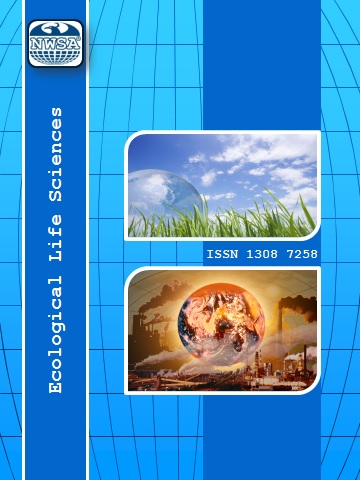References
[1] Barber, I., (2007). Parasites, behaviour and welfare in fish. Applied Animal Behaviour Science. 104(3-4):251-264. https://doi.org/10.1016/j.applanim.2006.09.005.
[2] Ekigen, G., (1983). Tatlysu Balyk Parazitleri. Fyrat Üniversitesi Su Ürünleri Yüksek Okulu No:1, Fyrat Üniversitesi Basymevi, Elazy?, 253s,
[3] Hoffman, G.L., (2019). Parasites of North American freshwater fishes. Vol., Cornell University Press.
[4] Iwanowicz, D.D., (2011). Overview on the effects of parasites on fish health. In Proceedings of the Third Bilateral Conference between Russia and the United States. Bridging America and Russia with Shared Perspectives on Aquatic Animal Health. Vol., ed.eds. Citeseer, pp. 176-184. ISBN:978-0-9835611-0-1
[5] Chubb, J.C. and Powell, A.M., (1966). The Examination of Fish Parasites, Department of Zoology University of Liverpool, pp. 87-90.
[6] Hoffman, G.L. and Sinderman, C.J., (1962). Common parasites of fishes. U.S. Department of the Interior Fish and Wildlife Service, Washington, 18 p.
[7] Prichard, M.H. and Kruse, G.O.W., (1982). The Collection and Preservation of Animals Parasites. Yllustrations by M. Marcuson, Technical Bulletin No:1 Universityot Nebraska Press. 118 p. ISBN:0803287046
[8] Ya?arol, ?., (1984). Medikal Parazitoloji, 2. basky, 514 s.
[9] Bykhovskaya-Povlovskaya, I.E., Gusev, A.V., Dubinina, M.N., Izyumova, N.A., Smirnova, T.S., Sokolovskaya, I.L., Shtein, G.A., Shulman, S.S. and Epshtein, V.M.,(1964).
[10] Key to Parasites of Freshwater Fishes of The USSR I Transll. Birrow. A. Et Cole, Z.S., Isr. Prog For Sci. Transl. Jeruselam, pp. 615-887.
[11] Bylund, G., (1975). The taxonomic significance of embryonic hooks in four European Diphyllobothrium species (Cestoda, Diphyllobothriidae), Acta Zool. Fenn., 142:1-21.
[12] Brown, A.F., Chub, J.C. and Veltkamp, C.J., (1986). A Key to The Species of Acanthocephala Parasitic in British Freshwater Fishes, J. Fish Biol., 28:327-334. https://doi.org/10.1111/j.1095-8649.1986.tb05169.x
[13] Chub, J.C., Pool, D.W., and Veltkamp, C.J., (1987). A key to the species of cestodes (tapeworms) parasitic in British and Irish freshwater fishes. J. Fish. Biol., 31:517-543. doi: 10.1111/j.1095-8649.1987.tb05256.x
[14] Scholz, T., (1997). A revision of the species of Botrhriocephalus Rudolphi, 1808 (Cestoda; Pseudophyllidea) parasitic in American freshwater fishes. Syst. Parasitol., 36: 85-107. doi:10.1023/A:1005744010567
[15] Hoffman, G.L., (1999). Parasites of North American Freshwater Fishes (Second edition), Comstock Publishing Associates a division of Cornell University Pres Ithaca and London, 539 p. https://doi.org/10.7591/9781501735059.
[16] Scholz , T., Shimazu, T., Olson, P.D., and Nagasawa, K., (2001). Caryophyllidean tapeworms (Platyhelminthes: Eucestoda) from freshwater fishes in Japan. Fol. Parasitol., 48: 275-288. doi: 10.14411/fp.2001.046
[17] Amin, Ö.M., Abdullah, S.M.A., and Mhaisen, F.T., (2003). Neoechinorhynchus (Neoechinorhynchus) zabensis sp. n. (Acanthocephala: Neoechinorhynchidae) from freshwater fish in northern Iraq. Folia Parasitol 8Praha) 50(4):293-7, doi: 10.14411/fp.2003.048.
[18] Schmidt, G.D. and Roberts, L.S., (1989). Foundations of Parasitology, Mosby College Publishing, Fourth Edition. ISBN 9780073028279,701p.
[19] Bush, A.O., Lafferty, K.D., Lotz, J.M., and Shostak, A.W., (1997). Parasitology Meets Econlogy on its own Terms. Revised at Margolis J. Parasitology, 83(4):575-583, https://doi.org/10.2307/3284227.
[20] Sümbülo?lu, K. ve Sümbülo?lu, V., (2021). Biyoistatistik. Hatibo?lu Yayyncylyk, 20. Basky, Ankara, ISBN:9789757527121, 299s.
[21] Williams, H. and Jones, A., (1994).Parasitic worms of fish. Taylor & Francis Ltd., London. 593 p., doi: doi.org/10.1201/b12595.
[22] Sutherland, D.R., (1989). Seosonal Distribution and Ecology of Three Helminth Species Infecting Carp (Cyprinus carpio) in Northwestlowa U.S.A. Canadian Journal of Zoology, 67:692-698, https://doi.org/10.1139/z89-100.
[23] Aksoy, ?. ve Saryeyyüpo?lu, M., (2000). Hazar Gölünden (Elazy?) Yakalanan Capoeta capoeta umblada Endohelmintlerin Ara?tyrylmasy. Fyrat Üniversitesi Fen ve Mühendislik Bilimleri Dergisi, 12(1):345-351.
[24] Ödennig, K., (1989). New Trends in Parasitic Infections of Cultured Freshwater Fish, Vet. Parasitol., 32(1):73-100. doi: 10.1016/0304-4017(89)90156-8.
[25] Scholz, T., Kuchta, R., Williams, C., (2012). Bothriocephalus acheilognathi. In Fish parasites: Pathobiology and protection. Vol., ed. CABI Wallingford UK., pp:282-297. https://doi.org/10.1079/9781845938062.0282.
[26] Öztürk, O.M., Aydo?du, A., and Do?an, I., (2002). The occurrense of the helminth fauna in Sand Goby (Gobius fluviatilis Palas, 1811) from Lake Uluabat, Turkey. Act. Vet. (Beograd), 52:381-392. doi: 10.2298/AVB0206381O.
[27] Rodger, H.D., (1991). Diphyllobothrium sp. Infections in Freshwater Reared Atlantic Salmon (Salmo salar L), Aquacultur, 95(1-2):7-14. https://doi.org/10.1016/0044-8486(91)90068-I.
[28] Jorge, R., (1993).Diphyllobothrium dendreticum and Diphyllobothrium latum in Fishes From Southern Argentina, Association, Abudance, Distribution, Pathological Effects and Risk of Human Infection, J. Parasitol. 79(3):379-383. doi: 10.2307/3283573.
[29] Sa?lam, N. ve Saryeyyüpo?lu, M., (2002). Capoeta trutta Baly?ynda Rastlanan Neoechinorhynchus rutili nin Yncelenmesi, Türkiye Parazitoloji Dergisi, 26(3):329-331.
[30] Lesseriere, O.L. and Crompton, D.W.T., (1988). Evidence for post-cyclic transmission in the life-history of Neoechinorhynchus rutili (Acanthocephala). Parasitol., 97:1-5. doi: 10.1017/s0031182000058534.
[31] Dörücü, M., Crompton, D.W.T., Huntingford, F.A., and Walters, D.E., (1995). The Ecology of Endoparasitic Helminths Infections of Brown trout (Salmo trutta) and Rainbow trout (Oncorhynchus mykiss) in Scotland, Folia Parasitologica, 42:29-3.
[32] Özcan, M. and Bozdo?an, N., (2020). Molecular identification of Neoechinorhynchus rutili parasite diagnosed in some fish species caught in Menzelet dam lake in Kahramanmaras province (Turkey). Saudi Journal of Biological Sciences. 27:1717-1721. doi: 10.1016/j.sjbs.2020.04.047.
[33] Oguz, M.C., Amin, O.M., Heckmann, R.A., Tepe, Y., Johargholizadeh, G., Aslan, B., and Malek, M., (2012). The discovery of Neoechinorhynchus zabensis (Acanthocephala: Neoechinorhynchidae) from cyprinid fishes in Turkey and Iran, with special reference to new morphological features revealed by scanning electron microscopy. Turkish Journal of Zoology. 36:759-766. https://doi.org/10.3906/zoo-1106-8.
[34] Arda, M., Seçer, S. ve Saryeyyüpo?lu, M., (2002). Balyk Hastalyklary, Medisan Yayyn Serisi: 56, Ankara, 142s.
[35] Pancharatnam, S., Jacob, E.. and Kang, G., (1998). Human diphyllobothriasis: first report from India. Trans. Roy. Soc. Tropic. Med. Hyg., 92:179-180.
[36] doi: 10.1016/s0035-9203(98)90737-4.
[37] Torres, P., Lopez, J.C., Cubillos, V., Lobos, C., and Silva, R., (2002). Visceral diphyllobothriasis in a cultured rainbow trout, Oncorhynchus mykiss (Walbaum), in Chile. J. Fish Dis., 25:375-379. doi: 10.1046/j.1365-2761.2002.00381.x.
 +90(535) 849 84 68
+90(535) 849 84 68 nwsa.akademi@hotmail.com
nwsa.akademi@hotmail.com Fırat Akademi Samsun-Türkiye
Fırat Akademi Samsun-Türkiye
